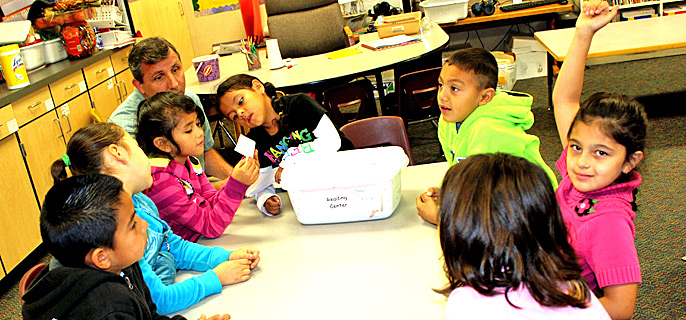
PHOTOS BY JENNIFER COLTON
In a kindergarten classroom at McNary Heights Elementary, students spent Wednesday morning learning about the letter “V”. The students checked their name tags to see if the letter was in their name; they wrote it in capitals and lowercase and over vegetables – a word beginning with the letter of the day.
The lesson could mimic any kindergarten classroom across the county – except that in this classroom, the entire lesson took place in Spanish.
Over the next three years, the students in the bilingual program will learn reading concepts in Spanish and slowly transition those skills into English, according to David Lougee, English language learners program coordinator for the Umatilla School District.
Umatilla first launched its bilingual education program in 2000 to work with Spanish-speaking students who entered school with little or no English skills. Since then, the program has expanded to focus on students with high Spanish-speaking skills, even if they speak English.

All students are tested for English and Spanish fluency in kindergarten; about 60 percent of new Umatilla students qualify as English-language learners, and about 30 will go into the bilingual program. In kindergarten, students are pulled from their regular classes for a separate reading lesson in Spanish. In first and second grade, however, the bilingual students have their own class together and take two reading lessons a day – one in English and one in Spanish.
On Wednesday, students in Elisabet Flores’ first-grade class separated into four groups during their Spanish reading lesson: Some students worked with an aide to repeat letter sounds, some identified words on flash cards, and some read a short story.
“Last year’s first-graders, by the end of the year, were the top English reading group in the school,” Lougee said. “The program has been pretty successful. Last year, the third-grade students who had been through the bilingual program scored the highest on OAKS – higher than third grade overall, and that’s on reading and comprehension.”
With the bilingual program’s success, the district is now looking at expanded it to become a true dual language program.
“What we have right now is a transitional bilingual program – we use it to transition students to English,” Lougee said. “It’s a good model, and a good program, but dual language is even stronger.”
The difference between the two programs comes down to segregation. In the bilingual classes, students in the program learn skills in their own classes; in dual language, native English-speakers and native Spanish-speakers learn together.
“You take your native English-speakers and your native Spanish-speakers and put them together,” Lougee said. “They’re taught in English for a portion of the day, and they’re taught in Spanish for a portion of the day. The native Spanish-speakers benefit by learning English and the native English-speakers benefit by learning Spanish. The other thing about dual language is it brings cultures together and it unifies by giving common goals. It’s a win-win.”
The district has started planning a program, but Lougee has applied for a Dual Language/Two-Way Bilingual Grant from the Oregon Department of Education that could fast-track the process and enhance the programs. The maximum awarded by the grant is $120,000, paid over three years, for design and implementation of a program.
The grant would allow the district to:
• Expand the bilingual/dual language program into preschool, fourth and fifth grade
• Create a Spanish instruction program for English-speaking students
• Purchase additional materials in Spanish, primarily picture and chapter books
• Pay for travel for training and school visits to design a dual language program
• Pay for substitutes during staff training
“Our numbers are showing the more bilingual education students get, the stronger readers they’re going to be later on, so we know we’re on the right track,” Lougee said. “This grant would allow us to do so much more, and, maybe some day these kids will be running these programs.”








